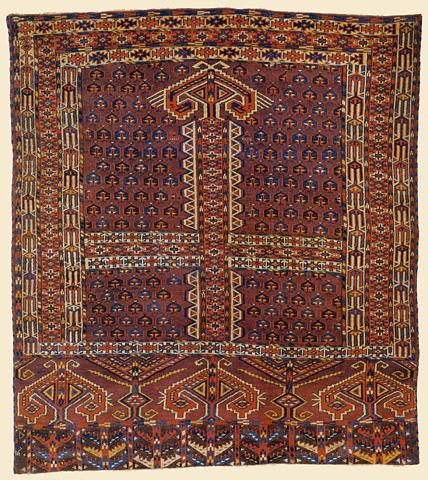 .
.Best regards.
Candles in the Garden
John,
One suggestion of the engsi design mentions candelabra. I
do not recall ever having seen a picture of a Turkmen walking around with a
candelabrum. I also do not recall a Turkmen tradition of placing dozens of them
in a rectangular enclosure.
Now, I can visualize a Victorian carpet scholar
wandering around his granite castle with one, puzzling over the mystical
iconography of his rugs. "Eureka! They must be candle holders!" he excitedly
exclaims.
You briefly noted:
Some have also suggested that the
"hatchli" design denotes a kind of "garden."
The garden theory makes the
most sense if you assume that the oldest engsi's are those of the hatchli
design. A family would weave their own garden as the entrance to their family
home, representative of fecundity, wealth and stature.
The inner border is
the fence of the garden, with the mihrab as the entrance arch to the garden.
The cross-hatch in the middle is the typical stream of water, similar to those
seen on the Kurdish garden carpets.
The so-called "candelabra" devices are
fruit trees pruned for maximum yield and short stature, just like any
commercial orchard today, in regular rows.
Outside the inner border is the
main border of larger trees, seen "from the front" in the panel at the bottom
of the field and see "from the tops" as these trees march up the sides of the
rug.
At the top of the field is a garden of shrubs, and at the bottom of the
engsi the elem is the beginning of "the outside world" of a desert or
scrublands.
The outer border of white rectangles with hooked crosses may be
the border of the property within which the formal fruit tree garden
resides.
So, until I see a picture of a Turkman candle carrier, I will
stick with my own fanciful idea.
Patrick Weiler
Hi Patrick,
Nice thoughts, but one problem: the oldest pieces
would come from the early Turkmen - say, 18th century (there are some people
who think it's earlier, but it doesn't matter right now whether they're right
or wrong). The early Turkmen didn't have houses and gardens, they were nomadic.
I agree, though, that the "candelabra" aren't likely to have been
intended to represent candelabra, that's just what they look like to us.
Regards,
Steve Price
The 'candelabra' are generally assumed to be stylized bird's heads.
According to some 'experts,' the more articulated the 'heads,' the earlier the
Ensi. One of the first 'lessons' I received as a Turkmen collector was from
George O'Bannon who said that the marks of an early Tekke ensi are: rounded
rosettes at the bottom, small number of birds' heads per row (two on each
side), and 'realistic' portrayal of the heads. I am merely repeating what he
said - I have no opinion one way or another on the matter.
Regards,
Yon
The bird-head idea is probably the most accepted by Turkoman collectors.
Here is another Yomud engsi from my collection which demonstrates the
"feathers" on the "eagle". Is it an "eagle"? In my opinion it is two birds or
othwer animals facing a central tree. .
.
Best regards.
No House ! No Garden !
Steve,
I appreciate that nomads had no house or garden
 , but the representation
of a formal, walled garden/orchard is not too far fetched, considering that the
oasis cities of Eastern Turkestan and the settled towns of Iran to the south
had gardens for many centuries.
, but the representation
of a formal, walled garden/orchard is not too far fetched, considering that the
oasis cities of Eastern Turkestan and the settled towns of Iran to the south
had gardens for many centuries.
Similarly, just as the Qashqai didn't
"have" their own Persepolis, that did not preclude them from representing it on
their rugs - it was their only way of "taking it with them".
The Garden of
Paradise is a theme that goes way back before these rugs we have today were
made in the 19th century.
The Garden of Paradise would take the shape of
the most perfect garden they could imagine, one with flowing water, fruit trees
and the security and privacy of a wall.
If they were just trying to imitate
a door, then why are the rugs not made with vertical panels imitating boards?
And where is the latch, lock or handle?
It has been suggested that many
rugs have themes of flowers so the weaver can keep a picture of a beautiful
spring day with her when perhaps the environment is a little less pleasant.
Maybe even really dry and hot.
![]()
Patrick Weiler
I wouldn't disagree that the fields of this engsi represent some kind of plant form or a whole garden.
Hi Patrick,
Your argument that they aren't candelabra is that the
Turkmen probably didn't have candelabra, so they wouldn't represent them on the
ensi. But if that argument is sound, wouldn't it also follow that the thing
doesn't representa garden because the Turkmen didn't have gardens?
I
don't know what the motif represents, and I agree that on a scale of
probabilities a garden seems more likely than candelabra. I'm not sure I can
conjure up a consistent argument for this point of view,
thougn.
Regards,
Steve Price
Candles in the garden
I am a first time writer into these forums but follow frequently the
discussions.
I thought these candelabra discussion being too "recent"
and of few meaning to the nomad's life. In the explanation of the engsi
designs, has anybody thought about making parallels with the famous Orient
Stars Seldjuk rug (from potala palace) that is also divided into 4 distinct
spaces with a magic animal in each quarter? If one looks at the negative space
, one can easily see the engsi cross design. The rug is filled with four magic
animal symbols but also with a lot of small birds whose heads remind of the
engsi designs.
Looking for an animal, magic symbol into the door of the
tent, the entrance of your intimate space probably meant more to the early
nomads than a usual object. The engsi form existed wherever people lived into
tents. So it would be interesting to make links with non central Asian engsis,
- as long as one is able to identify them!
Ali
Hi Ali,
The possible relationship of the Orient Stars
animal carpet to Turkmen ensis has been mentioned from time to time. I'm pretty
sure I remember hearing Thomas Cole say something about it, and Michael
Craycraft suggested it explicitly in a letter to HALI (issue #58, p. 89,
1991).
I have a copy of Orient Stars, but it's too big to fit
into the space where my scanner sits. I wonder if anyone out there would be
good enough to scan the image and post it (or send it to me or Filiberto for
posting).
Regards,
Steve Price
An Early Turkish Suggestion
Dear folks –
Mr. Tuna joins our discussion with the
suggestion that we look more deeply for possible sources of some of the design
and layout aspects of the Turkmen engsi.
He suggests that we might look
at the “Potala Palace Compartment” fragment that is Plate 185 in the
Orient Stars volume. I have scanned that image and here it is: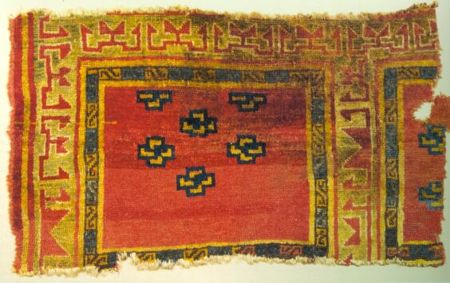
The text says that this piece is estimated to be
“early Konya,” 12th to 14th century. The fragment is 73 X 43
cm.
As Mr. Tuna points out the full rug seemingly had at least four
compartments, the “filler” devices in the red ground compartments
could be read to resemble in outline crude Turkmen chuval guls, and the
“major” border (the text says we cannot tell if it is so) is a design
that (again crudely) protrays two birds facing a tree. This could be an early
instance of the “animal trees” that caught the eyes of Pinner and
Franses in Turkmen Studies I. Or if one was intent on comparing this border
design with the “candelabras” in the panels of many Turkmen engsis,
one might argue that the “Y” shapes with beaks result from the
“birds” having “flown” into the “trees.” J
Rotation and reflection of devices by weavers is after all a longstanding
tradition.
Thanks to Mr. Tuna for this imaginative
suggestion.
Regards,
R. John Howe
Seljuk Animal Carpet
Hi People,
John Howe kindly scanned the Seljuk animal carpet from
Orient Stars. Here it is. 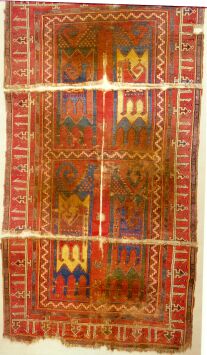
The four panel, ensi-like layout is obvious; the animal's curled tails
look mighty like Turkmen curled leafs.
Regards,
Steve Price
Dear Steve and al.
Thanks for mentioning the previous references to
the same idea in the past. Thanks also for posting the Orient Stars Animal
carpet for more clarity on the idea.
Actually, as I have sent the message
out ,I thought a better reference is the Anatolian Animal carpet from the
Metropolitan museum , probably same provenance and similar period. (it can bee
seen at the MET's site , under islamic art highlihts , carpets)
The MET
carpet does not have the field separated into the two compartments and one can
better see the 4 zone division and the resulting negative form. In addition ,
it is closer in dimension to the Turkoman Engsis (49 1/2 x 60 1/4) - this said
, I do not dare to suggest it was made as an Engsi. The existence of these rugs
show that there was a design tradition with that composition.
When I look at
the marvellous Engsi posted by Marvin Amstey in this tread , I also feel the
same Animal references both at the head of the pole , at the Elem and inside
the field. So the symbolism and the general layout seem to have
survived.
With the Salor engsi design , we more clearly see the presence of
animals.
With this body of - small I agree - evidence , to me the Engsi
language seems to have its origine within the animal realm and its protective
magic of the tent space rather than garden or candelabra symbols.
Ali
Dear All,
To follow up on references to garden and animal-tree
designs, I am attaching three photos of a Tekke ensi that clearly shows animals
beside trees. Some are facing the trees, others facing away. The "candelabra"
motif also shows what appear to be stylized crested bird or horned animals, but
those images are more ambiguous than obvious animals and trees. 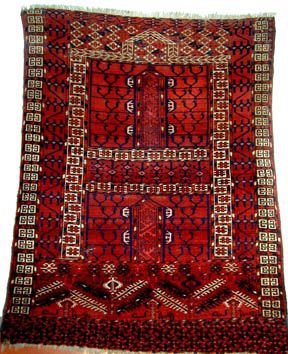
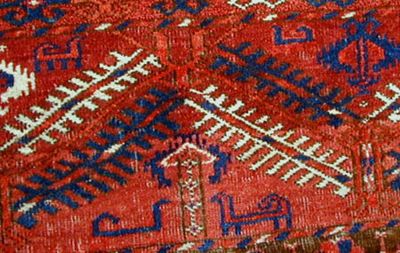
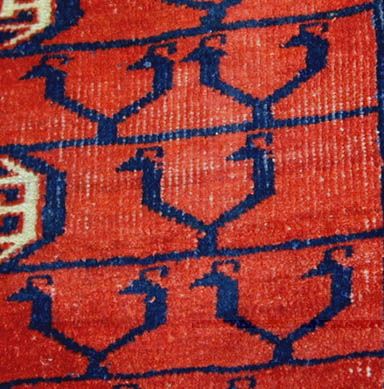
Best regards, Ken
Hi Ken,
The "bird head" motif on your (very attractive) piece
looks very much like the heads on what probably represent goats on many
Caucasian and NW Persian flatweaves. So, like you, I am unconvinced that they
are birds at all.
As long as we're on the subject of multiple bird heads
affixed to stems, here's an image for you: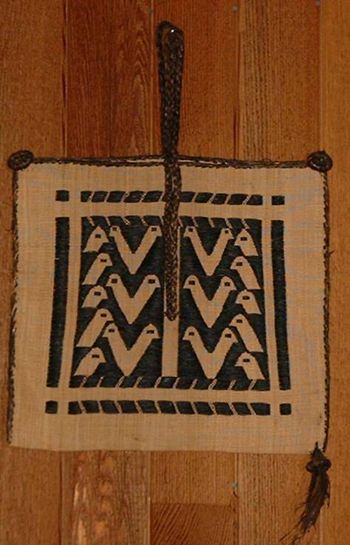
It's a woven raffia bag (natural and indigo dyed raffia are what gives
it the two colors) from Cameroon, made in the 1930's or so. These were prestige
objects within the tribal community, but many were made for sale to tourists. I
don't know which category this is from - it came from a missionary's estate. I
think the relationship it shows to Turkmen iconography is pretty striking,
another example of how certain motifs recur in places geographically remote
from each other. Generating the motifs in the negative space is characteristic
of these Cameroon bags.
Regards,
Steve Price
Dear Steve,
Thanks for posting that very fine Cameroon bag. I
hadn't realized that the two-bird or two-headed bird was also present in West
African art. Your bag is a remarkably sophisticated piece. Now if you can find
a Dogon ensi, we will really have some connections to explore.
Best
regards, Ken
Dogon Door
Hi Ken,
The Dogon don't use door rugs, but they do have doors.
Large ones for their homes, small ones for their granaries. These can be very
elaborate and are highly collectible.
Here's a full size Dogon
door: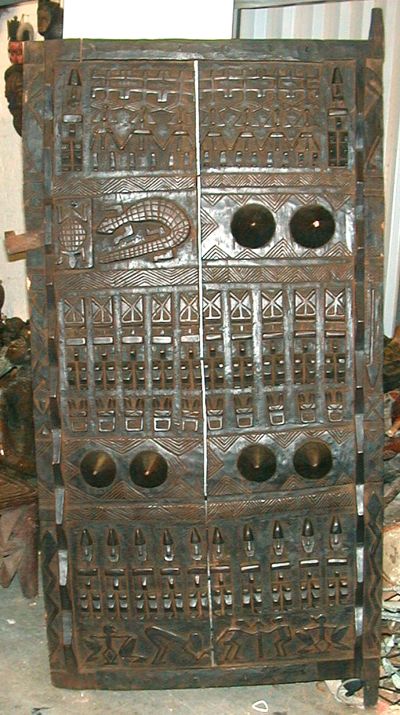
It's got a rich iconography, and with a
little stretching it's possible to see lots of formal similarity to Turkmen
ensis.
Regards,
Steve Price
That's ONE door I won't be knocking on......
Tibetan Door Rugs
Dear folks –
Since we are beginning to make analogies with
similar things in other cultures, it might be useful to note that the Tibetans
made and used door rugs all of which seem “compartmented” and most of
which have the “hatchli” format.
The usual Tibetan door rug
was apparently of cotton applique but pile versions of this format have been
published.
Chris Walters has for years used the door rug design below as
the signature piece for his Cultural Survival non-profit project with Tibetan
weavers in Nepal.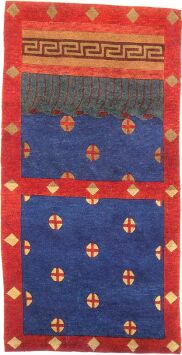
The “Woven Jewels” volume
(1992) on Tibetan rugs in Southern California collections provides two examples
of Tibetan door rug designs in pile.
The first is plate 40 in that
volume. This rug is precisely 3 feet by 5 feet.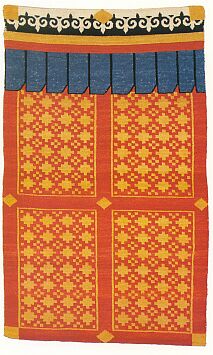
The second piece is plate 107 in this volume. 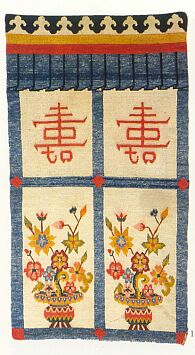
This third rug is 2 feet, 8 inches wide and 5 feet, 2
inches long.
There is even one published (also in “Woven
Jewels,” plate 41) Tibetan “window rug” with a similar format
attributed to the 19th century.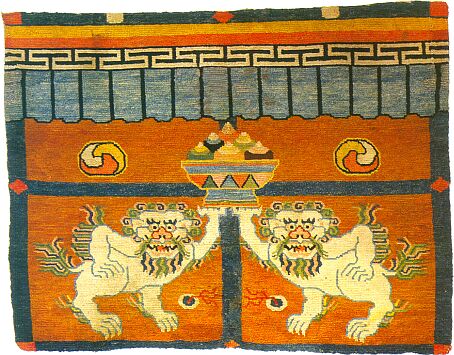
It measures 4 feet 4 inches by 3 feet, 6 inches.
I
asked Chris recently why Tibetan door rugs seem noticeably smaller than Turkmen
engsis. He said that it is likely because the Tibetans tend to be small people
and their tents and tent furnishings are appropriately smaller.
Eiland
says in his most recent “Comprehensive Guide” in his caption for the
second rug above, that settled Tibetans still sometimes use these door rugs in
their homes, despite their origin in a nomadic
setting.
Regards,
R. John Howe
A-hem… and what about the ensi cruciform layout being just an
imitation of a REAL door?
Like this one, for example: the Kaaba door - with
protective curtain: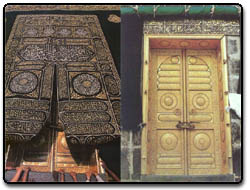
(It looks ancient but I have no idea of how old it
is.)
Or it’s a too prosaic
idea?
Prosaically,
Filiberto
Meaning of Tent Door Rug?
Significance of the Symbolism In the Engsi Carpet Design - Much has been made of the meaning or representitive significance of the design of the Turkmen Engsi, some explanations fanciful and some prosaic,and hopefully this interpretation of the design consists of a judicious admixture of both qualities. My interpretation of the symbolic meaning of the Engsi design proceeds from four points, the first point being the linguistic significance and implifications of the term "Tent Door Rug", the second would represent the illustrious history of the "Garden Carpet" design, a third the traditional interpretation of the Engs design as being that of the garden and/or door design,and a fourth which asserts that the engsi represents a visual and artistic "double entendre"; as such I believe that the engsi format depicts the superimposition of a door or window upon the field of a garden carpet and in turn a symbolic door to or window looking out upon a garden, either heavenly or earthly. I believe that the engsi design is not format specific and could well have seen dual use as an appropriate design for either a tent door or a prayer rug- even as a votive or decoration on festive occasions. -Dave Hunt
Origin of Engsi Design?
"Architectonically" rendered Garden Carpets, such as these three from
the Ellis translation of Antique Rugs of the Near East by Wilhelm Von Bode, are
believed to have been the inspiration for the garden designs of the Saryk
Engsi, and there are some interesting simularities. They are viewed as from
above, the garden being divided by irrigation and waterways, and dating from
the 17th to mid 18th centuries. Some of these rugs are quite large at 12'x30',
and speak much to Turkmen weaving. David Hunt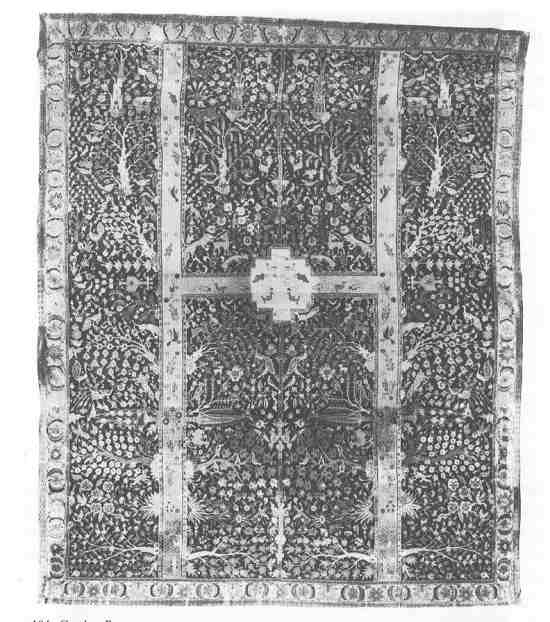
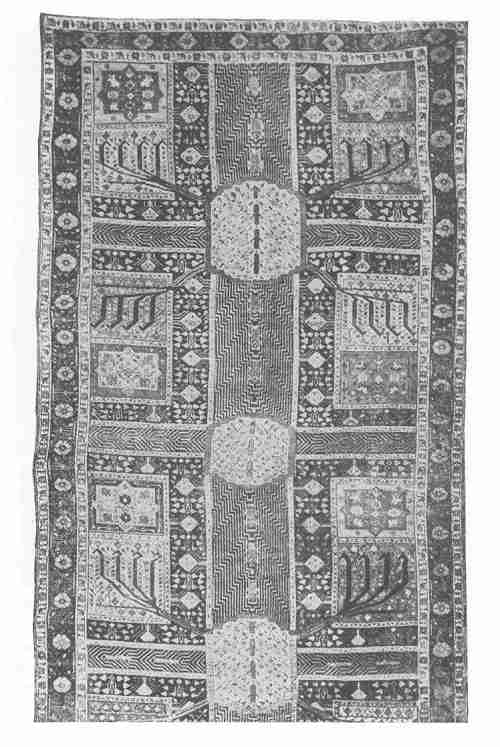
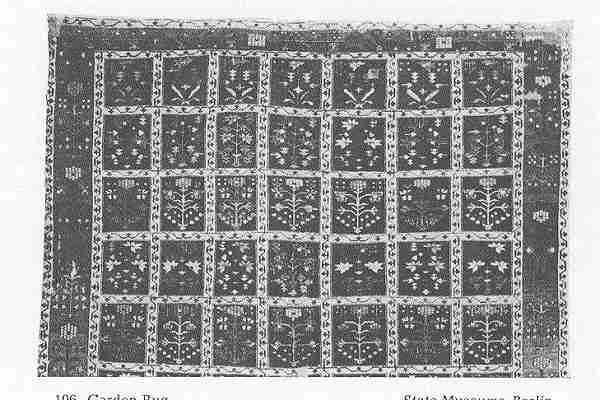
Candles in the Garden?
David,
I am glad you thought to reproduce some Garden Carpet
examples for this salon. Your middle example shows quite clearly the dark,
diagonal trunks of trees with finger-like branches. These branches, which angle
off at the tops, look remarkably like the "candelabra" in many engsi's.
Particularly the "sideways" candelabra in the Saryk engsi's. This may indicate
a more accurate rendition of the garden carpet among the various engsi
types.
The first rug shows trees which jut out perpendicularly from the
waterway and may represent an earlier, more naturalistic version.
One
conclusion that may be drawn from the Turkmen making "knock-offs" of formal
Persian Garden Carpets is that they wanted to emulate the wealth and beauty of
their neighbors.
One question that may be asked is where did they get
the Mother of All Garden Carpets to use as an example? Perhaps at one of the
Jiffy-Mart Quick-Stop Gas & Go stations along the Silk Road.
Patrick
Weiler
Pat -
The Turkmen wove knock-offs of Persian
designs???
Sacrilege!!!
I'd sooner believe they were inspired by
the "heavens."
Regards,
R. John Howe
To All- Please don't think of it as being a knock-off, so much as a reinterpretation, for the Safavids inhereted an artistic heritage from the Turks and Mongols which they retained and integrated inro their own style. Mosques and architecture from the Safavid era clearly retained the Turkic Styles. Note the medallions and indeed the overall geometric rendering of elements in the second of the three rugs, for the ornamentation both this rug and turkmen rugs in general are Turkic in origin.- Dave H.